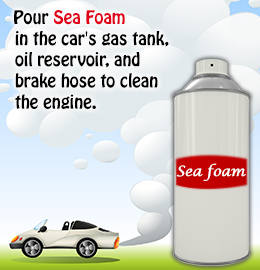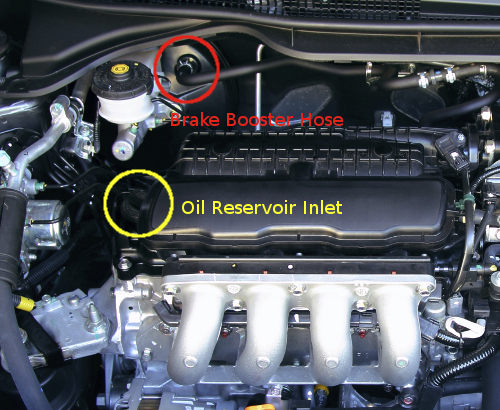
Why Sea Foam?The owner of Sea Foam, Fred Fandrei created the product to rid engine trouble in his outboard motor during his fishing trails. He sold it to fellow fisherman, who referred to it as sea foam, and that’s how Sea Foam got its name.For those who do not know, Sea Foam is a petroleum-based additive used to clean a car’s internal parts of accumulated carbon. It is easily available at local auto stores and can be purchased for about USD 20-22. Cleaning your car engine is essential to maintain its performance and fuel efficiency. The more accumulated dirt in your engine and injectors, the more fuel would be consumed by your car, leading to lower mileage, poor pickup, higher oil consumption, higher emission, and even overheating.
Hence, using a decarbonizing additive like Sea Foam is essential. You can ask a mechanic to add Sea Foam to your car, or you can even do it yourself. In case you’re thinking of the latter, you’ll need to understand the correct procedure to use Sea Foam. Refer to the instructions given below to use Sea Foam to clean your car’s engine.
How to Use Sea Foam
Prerequisites
- To begin with, you’ll need two cans of Sea Foam Motor Treatment additive.
- Ensure that your gas tank is half full.
- Get a long funnel with a thin nozzle.
- Choose an open, properly ventilated area to perform the task.
Cleaning the Fuel InjectorsThe main purpose of pouring Sea Foam in the gas tank is to get rid of the accumulated carbon and debris in the fuel injectors. To achieve this, take one of the two cans of Sea Foam and empty it into the car’s gas tank. Pouring it in can be a bit tricky as the nozzle of the bottle isn’t long enough, this is where you’ll need the funnel.
Once you’ve emptied your bottle, crank the engine and go for a nice little drive in your car. This will allow the gas mixed with Sea Foam to pass through the injectors and clean them. Try to run your car as much as possible to utilize most of the Sea Foam. Refuel only after your tank is almost empty, this is because refueling instantly would dilute the Sea Foam and hamper the cleaning process.
Cleaning the CrankcaseTo clean buildup residues from the crankcase, you’ll need to pour Sea Foam in the oil reservoir. An oil reservoir houses or contains your car’s engine oil. You can locate a knob or cap to open the vent of the reservoir, right under the hood. Check the illustration and also refer to your car’s manual if you aren’t sure about the location of the reservoir (in most cases it’s opening vent is close to the engine).

Once you’ve located it, you’ll have to pour Sea Foam in it. Don’t worry, pouring Sea Foam in your engine oil won’t do any harm as it is a petroleum-based substance, but it should be added in a certain proportion. 1.5 oz. of Sea Foam per quarter of oil is required. So if your car’s oil capacity is 4.4 quarts, you should pour in 6.6 oz. of Sea Foam, which is slightly above one-thirds of a 16 oz. bottle. In case you aren’t sure about your car’s oil capacity refer to the owner’s manual.
(Caution: Pour Sea Foam in the oil reservoir only when the car is cool, and not immediately after you drive home.)
After you have used the appropriate amount of Sea Foam, remember to change the oil after nothing more than 100 miles. This is because the oil would be mixed with all the carbon cleaned up by the Sea Foam and turn thick and black. Therefore, it’s strongly recommended that you change the oil after 100 miles.
Cleaning the Engine CoreTo feed Sea Foam to the engine core, you’ll need to locate a vacuum line that goes directly to the engine. The ideal one is the brake-booster hose. Determine its location under the hood using your car’s manual, it’s location is also quite clear from the above illustration (usually located besides the brake fluid). Also, remember to perform the engine cleaning in an open area, it’s going to churn out an immense amount of smoke. So much that your neighbors may rush to your house suspecting that it’s on fire.
To begin with, start the car and let the engine warm up for 5-10 minutes; then turn it off and open the hood to spot the brake-booster hose. Once you’ve located the hose, use pliers to loosen the clip holding it. Then, pull hard on it; this could be tricky as the hose is held tight by the vacuum inside. If you are unable to pull any harder, you can use a screwdriver or something that will slide in to obstruct the vacuum and disengage the hose easily.
Now, use the thin-nozzled funnel to pour Sea Foam into the brake hose; stick the funnel into the opening of the hose. Start the engine and slowly pour two-thirds of the remaining Sea Foam in the hose via the funnel. Do this very slowly as you don’t want to stall the engine; you’ll hear sputtering and choking, and also smoke puffing out of the exhaust, which is normal. Once you’re done with two-thirds, quickly empty the whole container into the hose; this should stall the engine, but if it doesn’t, quickly turn off the ignition.
Do not start the car for the next 20 minutes; let the engine nicely soak all the poured Sea Foam. After twenty minutes, reconnect the hose and any other disconnected components, and start your car. You may have trouble starting the car, but once it starts, go for a long drive. Choose a highway where you can drive freely without any obstructing traffic, you’ll need to drive at least at 60 miles per hour. Your car will exhale a lot of bluish smoke, which is normal in such circumstances.
Done! You’ve successfully Sea Foamed your car. A clean and well-lubricated engine is sure to run smoother and last longer.